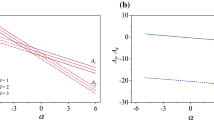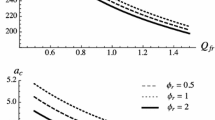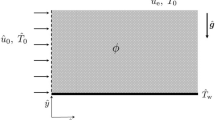Abstract
We study a forced convective three-dimensional flow and heat transfer in the porous medium. Temperatures of the fluid and solid phases are not identical leading to local thermal non-equilibrium (LTNE) conditions, and hence we require two heat transport equations: one for each phase. This model arises when a hot (cold) fluid flows through a relatively cold (hot) porous medium. This situation usually appears in geothermal and chemical engineering applications. The flows outside the boundary layers are approximated by a linear variation along with the streamwise directions. The governing equations that model the problem are solved numerically using the Chebyshev collocation method. The chief focus is on the application of the Chebyshev collocation method for the system of ordinary differential equations that essentially governing the fluid flow and heat transfer in the boundary layers. The numerical results show that the thickness of the boundary layer is thinner in the streamwise direction, and also predicts the reverse flow in the other direction for a negative three-dimensionality parameter. The thinning of the boundary layer thickness is found for higher permeability values. In the case of forced convection regime, both interphase rate of heat transfer and porosity scaled conductivity are decreased towards zero, the temperature of the fluid phase gradually deviates from solid porous medium temperature thereby showing LTNE effects. The various results corresponding to the LTNE are shown to be a continuation of the classical heat transfer already present in the local thermal equilibrium. The temperature difference which arises out of the LTNE is suitable in most industrial applications. Further, to assess the nature of these flows for a large time, a linear stability analysis is performed to see whether or not the obtained solutions are practically realizable. It is found that all the obtained solutions are always stable, and hence are indicative of practically significant. The fluid dynamics of these mechanisms are discussed in detail.











Similar content being viewed by others
References
Alizadeh R, Gomari SR, Alizadeh A, Karimi N (2019) Combined heat and mass transfer and thermodynamic irreversibilities in the stagnation-point flow of Casson rheological fluid over a cylinder with catalytic reactions and inside a porous medium under local thermal nonequilibrium. Comput Math Appl. https://doi.org/10.1016/j.camwa.2019.10.021
Alizadeh R, Karimi N, Mehdizadeh A, Nourbakhsh A (2019) Analysis of transport from cylindrical surfaces subject to catalytic reactions and non-uniform impinging flows in porous media. J Therm Anal Calorim. https://doi.org/10.1007/s10973-019-08120-z
Anzelius A (1926) Über erwärmung vermittels durchströmender medien. 6(4): 291–294, https://doi.org/10.1002/zamm.19260060404
Boyd JP (2000) Chebyshev and Fourier spectral methods, 2nd edn. Dover Publications, New York
Buonomo B, Oronzio M, Guy L (2014) Forced convection in micro-channels filled with porous media in local thermal non-equilibrium conditions. Int J Therm Sci 77:206–222
Celli M, Rees DAS, Barletta A (2010) The effect of local thermal non-equilibrium on forced convection boundary layer flow from a heated surface in porous media. Int J Heat Mass Transf 53(17–18):3533–3539
Davey A (1961) Boundary layer flow at a saddle point of attachment. J Fluid Mech 10(4):593–610
Davey A, Schofield D (1967) Three dimensional flow near a two-dimensional stagnation point. J Fluid Mech 28(1):149–151
Dehghan M, Valipour MS, Keshmiri A, Saedodin S, Shokri N (2016) On the thermally developing forced convection through a porous material under the local thermal non-equilibrium condition: an analytical study. Int J Heat Mass Transf 92:815–823
Devi CDS, Takhar HS, Nath G (1986) Unsteady three-dimensional boundary-layer flow due to a stretching surface. Int J Heat Mass Transf 29(12):1996–1999
Givler R, Altobelli S (1994) A determination of the effective viscosity for the Brinkman-Forchheimer flow model. J Fluid Mech 258:355–370
Gogate SPS, Bharathi MC, Kudenatti RB (2020) Heat transfer through mixed convection boundary layer in a porous medium: LTNE analysis. Appl Therm Eng. https://doi.org/10.1016/j.applthermaleng.2020.115705
Gorla RSR, Takhar HS (1987) Free convection boundary layer flow of a micropolar fluid past slender bodies. Int J Eng Sci 25(8):949–962. https://doi.org/10.1016/0020-7225(87)90090-5
Hashemi MS, Akgül A (2019) On the mhd boundary layer flow with diffusion and chemical reaction over a porous flat plate with suction/blowing: two reliable methods. Eng Comput. https://doi.org/10.1007/s00366-019-00876-0
Hassani H, Machado JT, Avazzadeh Z, Naraghirad E (2020) Generalized shifted Chebyshev polynomials: solving a general class of nonlinear variable order fractional pde. Commun Nonlinear Sci Numer Simul 85:105229
Hayat T, Khan MI, Imtiaz M, Alsaedi A, Waqas M (2016) Similarity transformation approach for ferromagnetic mixed convection flow in the presence of chemically reactive magnetic dipole. Phys Fluids. https://doi.org/10.1063/1.4964684
Hewitt RE, Duck PW, Stow SR (2002) Continua of states in boundary-layer flows. J Fluid Mech 468:121–152
Howarth L (1951a) The boundary layer in three dimensional flow: the flow near a stagnation point. Philos Mag 42(334):239–243
Howarth L (1951b) Note on the boundary layers on a rotating sphere. Philos Mag 42(334):1308–1315
Howarth L (1951c) The boundary layer in three dimensional flow: derivation of the equations for flow along a general curved surface. Philos Mag 42(334):1433–1440
Hussain T, Afzal N (1988) Mixed convection boundary layer flow on a horizontal plate in a uniform. Int J Heat Mass Transf 31(12):2505–2516. https://doi.org/10.1016/0017-9310(88)90176-7
Jonathan E-K, Preston I, Paterson L (2005) Onset of convection in anisotropic porous media subject to a rapid change in boundary conditions. Phys Fluids 17:8. https://doi.org/10.1063/1.2033911
Karmakar T, Reza M, Sekhar GPR (2019) Forced convection in a fluid saturated anisotropic porous channel with isoflux boundaries. Phys Fluids. https://doi.org/10.1063/1.5126892
Kudenatti RB, Gogate SPS (2020) Two-phase microscopic heat transfer model for three-dimensional stagnation boundary-layer flow in a porous medium. J Heat Transf. https://doi.org/10.1115/1.4045412(2)
Kudenatti RB, Kirsur SR (2017) Numerical and asymptotic study of non-axisymmetric magnetohydrodynamic boundary layer stagnation-point flows. Math Methods Appl Sci 40(16):5841–5850
Kudenatti RB, Noor-E-Bharathi, Bharathi MC (2020a) Boundary-layer flow of the power-law fluid over a moving wedge: a linear stability analysis. Eng Comput. https://doi.org/10.1007/s00366-019-00914-x
Kudenatti RB, Noor-E-Misbah, Bharathi MC (2020b) Linear stability of momentum boundary layer flow and heat transfer over a moving wedge. J Heat Transf. https://doi.org/10.1115/1.4046645
Kudenatti RB, Noor-E-Misbah, Bharathi MC (2020) Stability of hydromagnetic boundary layer flow of non-Newtonian power-law fluid flow over a moving wedge. Eng Comput 10:10. https://doi.org/10.1007/s00366-020-01094-9
Libby PA (1967) Heat and mass transfer at a general three-dimensional stagnation point. Am Inst Aeronaut Astronaut J 5(3):507–517. https://doi.org/10.2514/3.4008
Makinde OD, Khan ZH, Ahmad R, Khan WA (2018) Numerical study of unsteady hydromagnetic radiating fluid flow past a slippery stretching sheet embedded in a porous medium. Phys Fluids. https://doi.org/10.1063/1.5046331
Mansour M, El-Anssary N, Aly A (2008) Effects of chemical reaction and thermal stratification on mhd free convective heat and mass transfer over a vertical stretching surface embedded in a porous media considering soret and dufour numbers. Chem Eng J 145(2):340–345
Mathie R, Nakamura H, Markides CN (2013) Heat transfer augmentation in unsteady conjugate thermal systems-Part II: applications. Int J Heat Mass Transf 56:819–833. https://doi.org/10.1016/j.ijheatmasstransfer.2012.09.017s
Mondal S, Konar P, Mahapatra T, Sibanda P (2019) Mhd boundary layer liquid metal flow in the presence of thermal radiation using non-similar solution. Numer Heat Transf Fluid Flow. https://doi.org/10.1007/978-981-13-1903-738
Nield D, Bejan A (2013) Convection in porous media, 4th edn. Springer, New York
Nield DA (1999) Modeling the effects of a magnetic field or rotation on flow in a porous medium: momentum equation and anisotropic permeability analogy. Int J Heat Mass Transf 42:3715–3718
Othman NA, Yacob NA, Bachok N, Ishak A, Pop I (2017) Mixed convection boundary-layer stagnation point flow past a vertical stretching/shrinking surface in a nanofluid. Appl Therm Eng 115:1412–1417
Parand K, Shahini M, Dehghan M (2010) Solution of a laminar boundary layer flow via a numerical method. Commun Nonlinear Sci Numer Simul 15(2):360–367
Prasad VR, Vasu B, Bég OA (2011) Thermo-diffusion and diffusion-thermo effects on mhd free convection flow past a vertical porous plate embedded in a non-darcian porous medium. Chem Eng J 173(2):598–606
Rees DAS (2011) The effect of local thermal nonequilibrium on the stability of convection in a vertical porous channel. Transport Porous Med 87(2), 459–464. 10:1007/s11242-010-9694–5
Rees DAS, Pop I (2005) Local thermal non-equilibrium in porous medium convection, pp. 147–173. Transport phenomena in porous media III, (Edited by Ingham D. B. and Pop I.), Elsevier, Great Britain. https://doi.org/10.1016/B978-008044490-1/50010-7
Rees DAS, Andrew PB, Siddheshwar PG (2008) Local thermal non-equilibrium effects arising from the injection of a hot fluid into a porous medium. J Fluid Mech 594(1):379–398. https://doi.org/10.1017/S0022112007008890
Rosali H, Ishak A, Pop I (2016) Mixed convection boundary layer flow near the lower stagnation point of a cylinder embedded in a porous medium using a thermal nonequilibrium model. ASME J Heat Transf 138:8. https://doi.org/10.1115/1.4033164
Rosenhead L (1963) Laminar boundary layers. Clarendon Press, Oxford
Salleh MZ, Nazar R, Pop I (2009) Forced convection boundary layer flow at a forward stagnation point with Newtonian heating. Chem Eng Commun 196(9):987–996
Schlichting H, Gerstern K (2004) Boundary layer theory, 8th edn. Springer-Verlag, New Delhi
Schumann TEW (1929) Heat transfer: a liquid flowing through a porous prism. J Franklin Inst, 208:405–416
Scott NL, Straughan B (2013) A nonlinear stability analysis of convection in a porous vertical channel including local thermal nonequilibrium. J Math Fluid Mech 15(1):171–178. https://doi.org/10.1007/s00021-012-0109-y
Shook GM (2001) Predicting thermal breakthrough in heterogeneous media from tracer tests. Geothermics 30(6):573–589
Stopa J, Wojnarowski P (2006) Analytical model of cold water front movement in a geothermal reservoir. Geothermics 35(1):59–69
Straughan B (2006) Global nonlinear stability in porous convection with a thermal non-equilibrium model. Proc R Soc A Math Phys Eng Sci 462(2066):409–418
Straughan B (2013) Porous convection with local thermal non-equilibrium temperatures and with Cattaneo effects in the solid. Proc R Soc A Math Phys Eng Sci. https://doi.org/10.1098/rspa.2013.0187
Sun M, Hu C, Zha L, Xie Z, Yang L, Tang D, Song Y, Zhao J (2020) Pore-scale simulation of forced convection heat transfer under turbulent conditions in open-cell metal foam. Chem Eng J 389:124427
Tao LN (1960) On combined free and forced convection in channels. J Heat Transf 82(3):233–238. https://doi.org/10.1115/1.3679915
Turkyilmazoglu M (2011) Thermal radiation effects on the time-dependent mhd permeable flow having variable viscosity. Int J Therm Sci 50(1):88–96
Turkyilmazoglu M (2021) Stagnation-point flow and heat transfer over stretchable plates and cylinders with an oncoming flow: Exact solutions. Chem Eng Sci 238:116596
Vafai K, Tien CL (1981) Boundary and inertia effects on flow and heat transfer in porous media. Int J Heat Mass Transf 24:195–203
Wang CY (1984) Three-dimensional flow due to stretching flat surface. Phys Fluids 27(8):1915–1917
Weidman PD (2012) Non-axisymmetric Homann stagnation-point flows. J Fluid Mech 702:460–469
Weidman PD, Kubitschek DG, Davis AMJ (2006) The effect of transpiration on self-similar boundary layer flow over moving surfaces. Int J Eng Sci 44(11–12):730–737
Yasin MHM, Ishak A, Pop I (2017) Boundary layer flow and heat transfer past a permeable shrinking surface embedded in a porous medium with a second-order slip: A stability analysis. Appl Therm Eng 115:1407–1411. https://doi.org/10.1016/j.applthermaleng.2016.08.080
Yuan SW (1988) Foundations of fluid mechanics. Prentice of India, New Delhi
Acknowledgements
The various useful and educative comments from the anonymous reviewers are highly acknowledged.
Author information
Authors and Affiliations
Corresponding author
Additional information
Publisher's Note
Springer Nature remains neutral with regard to jurisdictional claims in published maps and institutional affiliations.
Rights and permissions
About this article
Cite this article
S, S.P.G., Noor-E-Misbah, M C, . et al. Local thermal non-equilibrium effects in forced convection stagnation boundary layer flows in a porous medium: the Chebyshev collocation method for coupled system. Engineering with Computers 39, 1249–1266 (2023). https://doi.org/10.1007/s00366-021-01492-7
Received:
Accepted:
Published:
Issue Date:
DOI: https://doi.org/10.1007/s00366-021-01492-7




